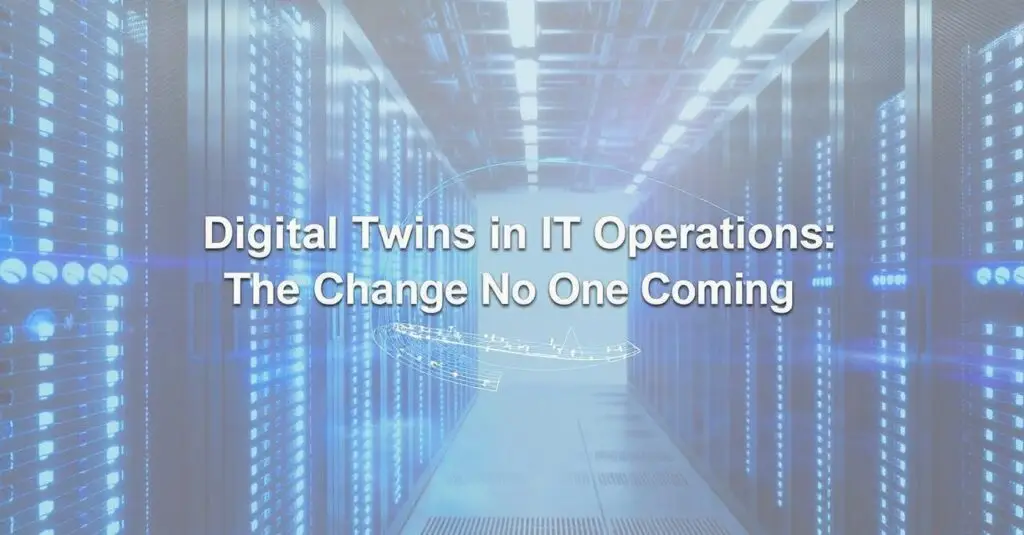In today’s technology-driven world, enterprises are constantly seeking smarter and more predictive ways to manage their IT operations. One such powerful innovation is the concept of digital twins—virtual representations of physical systems that mirror real-time behaviors, conditions, and performance. While digital twins have long been associated with manufacturing and engineering, they are now quietly disrupting IT operations, creating waves across the enterprise technology landscape. How Digital Twins Work in IT Contexts At the core of a digital twin lies the ability to simulate, monitor, and optimize processes. In IT operations, digital twins represent IT assets, infrastructure, networks, or even entire data centers. These twins continuously gather data from their physical counterparts through sensors, logs, APIs, and telemetry tools. The insights derived from this live data feed enable IT teams to proactively manage systems, prevent outages, and fine-tune performance—all in a virtual environment. By enabling real-time diagnostics and predictive analytics, digital twins are quietly disrupting IT operations by helping companies move from reactive maintenance to proactive optimization. This paradigm shift is transforming IT infrastructure from a cost center into a strategic business enabler. Enhanced Infrastructure Monitoring and Predictive Maintenance One of the most impactful applications of digital twins in IT operations is infrastructure monitoring. Traditional monitoring tools offer static or reactive insights based on historical data. In contrast, digital twins model the full behavior of infrastructure elements in real time. For example, a digital twin of a server cluster can detect unusual power consumption patterns, overheating trends, or irregular memory usage. Before these issues escalate into service disruptions, the digital twin can trigger alerts and even recommend corrective actions. This predictive maintenance capability significantly reduces downtime, minimizes mean time to repair (MTTR), and extends the lifespan of IT assets. Such capabilities are vital in environments where uptime is non-negotiable, such as healthcare, banking, and e-commerce. It’s in these sectors that digital twins are quietly disrupting IT operations by enabling a more intelligent, autonomous, and agile approach to maintenance. Boosting Cybersecurity with Simulated Environments Cybersecurity is another area where digital twins are proving indispensable. IT teams can use digital twins to simulate networks, applications, or devices to test vulnerabilities without exposing the actual systems to risk. This allows for the creation of cyber ranges—safe, virtual environments where organizations can simulate cyberattacks, assess their defenses, and refine their incident response strategies. Moreover, because digital twins are constantly fed real-time data, they can detect anomalies indicative of a breach or malicious activity before it causes harm. This proactive approach makes digital twins quietly disrupting IT operations by making cybersecurity operations smarter and more preventive. IT Capacity Planning and Performance Optimization Capacity planning has always been a difficult challenge for IT operations. Overprovisioning leads to wasted resources, while underprovisioning causes system bottlenecks. Digital twins provide a virtual testbed to experiment with different workload scenarios and configurations without affecting live systems. For instance, when planning for a major software rollout or infrastructure migration, IT teams can use a digital twin to simulate load conditions, traffic surges, and resource utilization. These simulations help IT managers fine-tune configurations, validate infrastructure readiness, and allocate resources efficiently. This kind of real-time simulation is why digital twins are quietly disrupting IT operations, helping businesses make data-driven decisions that optimize system performance and reduce costs. Accelerating DevOps and CI/CD Pipelines In DevOps environments, where speed and reliability are paramount, digital twins offer a distinct advantage. Developers and IT operations teams can use digital twins to simulate the full stack—from application code to infrastructure—and test new features in a controlled environment. This enhances the Continuous Integration/Continuous Deployment (CI/CD) process by enabling early detection of bugs, compatibility issues, or performance regressions. Furthermore, digital twins can automatically analyze deployment metrics and user feedback to refine the pipeline for future updates. As a result, digital twins are quietly disrupting IT operations by improving DevOps velocity, release quality, and system resilience. Digital Twins and AIOps: A Synergistic Future The future of IT operations is clearly moving toward autonomous systems powered by Artificial Intelligence for IT Operations (AIOps). When combined with AIOps, digital twins become even more powerful. AIOps platforms can analyze the vast datasets produced by digital twins and generate intelligent insights, recommendations, and even automated actions. For instance, in the event of an impending server overload, the AIOps engine can predict the failure using data from the digital twin and automatically reallocate resources, scale cloud capacity, or initiate a failover—all without human intervention. This intelligent, automated operational model is the reason why digital twins are quietly disrupting IT operations, making them smarter, faster, and more autonomous. Digital Twins and ITSM Integration IT Service Management (ITSM) systems can also benefit greatly from digital twins. Traditional ITSM relies on static CMDBs (Configuration Management Databases) that are often outdated. Digital twins keep these records alive by feeding them real-time data, ensuring configuration items are accurate and up to date. With this integration, incident management, problem resolution, and change management become more efficient. For example, when an incident is raised, the system can instantly refer to the digital twin of the affected asset and identify root causes, past incidents, or change history—reducing time to resolution. This dynamic CMDB model exemplifies how digital twins are quietly disrupting IT operations by making ITSM processes more intelligent and data-driven. Improved User Experience and Service Reliability End-user satisfaction is a key metric in evaluating IT operations success. Digital twins help IT teams anticipate problems before they reach the user. For instance, in a retail environment, a digital twin can simulate user journeys across applications, APIs, and backend infrastructure. This helps in identifying potential choke points, errors, or latency issues before they degrade the user experience. When paired with real-time monitoring tools, digital twins can automatically trigger remediation steps such as cache flushing, server scaling, or API rerouting. This proactive service management is one more way digital twins are quietly disrupting IT operations by aligning IT outcomes with business expectations. Driving IT Sustainability and Cost Control With sustainability becoming a board-level agenda, IT operations are under pressure to reduce their carbon footprint. Digital twins can simulate energy usage, thermal output, and overall resource consumption of data centers. These insights help IT leaders make greener decisions, such as consolidating workloads, optimizing cooling systems, or migrating to cloud-native architectures. Furthermore, the cost visibility enabled by digital twins helps CIOs align IT spending with ROI metrics, ensuring leaner and more sustainable operations. This dual advantage of sustainability and cost-efficiency is a strong reason why digital twins are quietly disrupting IT operations in the modern enterprise. The Future Outlook: A Digital Mirror for Every IT Asset Looking ahead, digital twins are expected to become a foundational element of digital infrastructure. From servers and storage systems to entire cloud environments, every component will eventually have a digital mirror that supports smarter, faster, and more resilient IT operations. As AI, machine learning, and edge computing technologies continue to mature, the fidelity and intelligence of digital twins will only grow stronger. Businesses that adopt this innovation early will not only optimize their operations but will also gain a competitive edge in agility, security, and innovation. Read Full Article : https://bizinfopro.com/blogs/it-blogs/how-digital-twins-are-quietly-disrupting-it-operations/ About Us : BizInfoPro is a modern business publication designed to inform, inspire, and empower decision-makers, entrepreneurs, and forward-thinking professionals. With a focus on practical insights and in depth analysis, it explores the evolving landscape of global business—covering emerging markets, industry innovations, strategic growth opportunities, and actionable content that supports smarter decision making.

Posted in2025
Digital Twins in IT Operations: The Change No One Saw Coming
?? External Website: https://bizinfopro.com/


